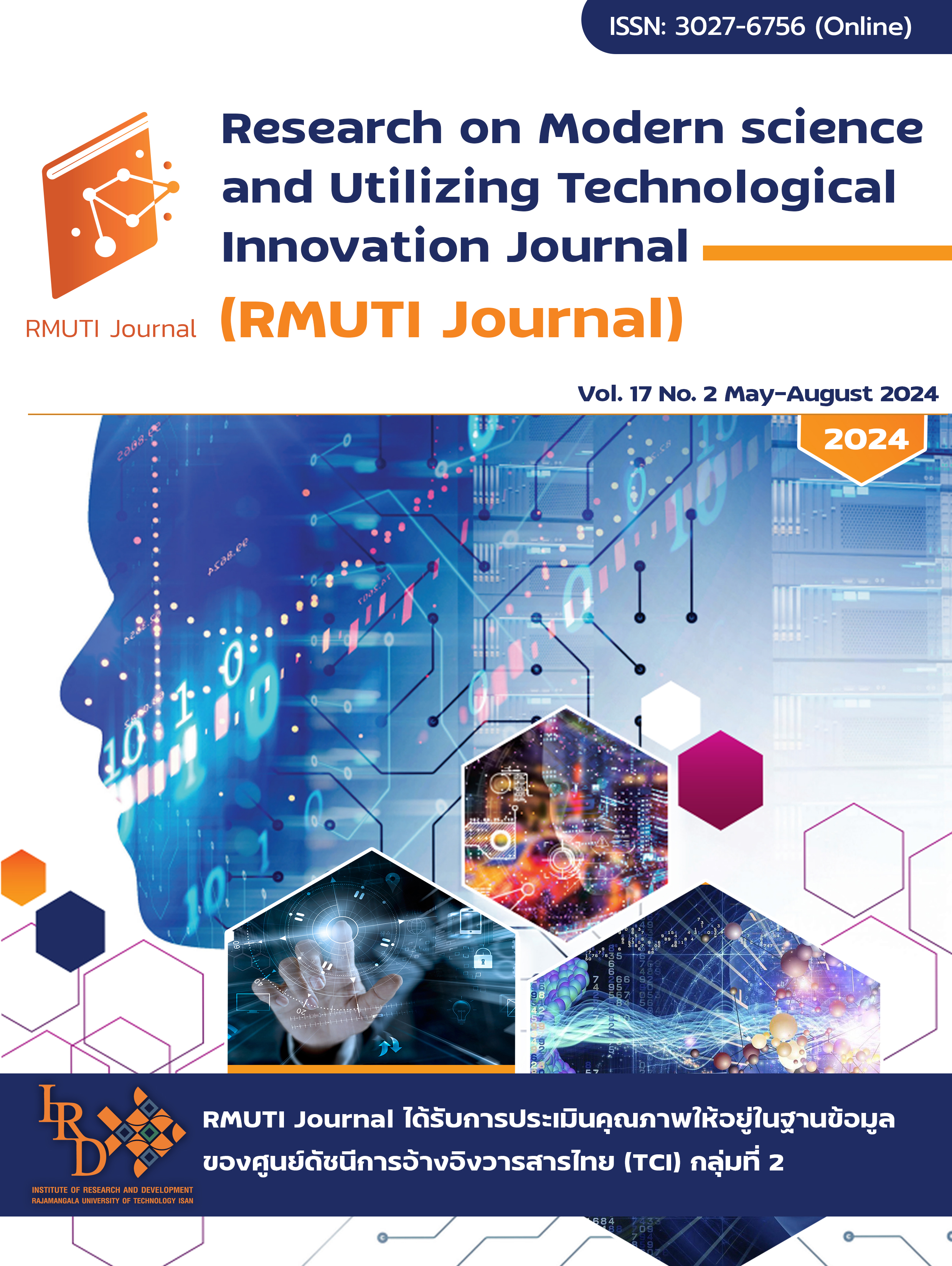Effect of Substitution of Wheat Flour with Cauliflower Powder on Qualities in Tuile Cookies
Main Article Content
Abstract
This study aims to investigate the factors affecting the quality of cauliflower powder, focusing on two variables: 1) pre-drying heat treatment (blanching and non-blanching) and 2) drying temperature (50 and 70 oC). A 2x2 factorial design in a Completely Randomized Design (CRD) was used. The color charateristics of the cauliflower powder were analyzed, revealing that blanching follwed by drying at 50 oC resulted in significantly higher lightness (L*) and lower redness (a*) and yellowness (b*) (p≤0.05). The chemical quality analysis showed that blanching and drying at 70 oC yeilded the lowest moisture content and water activity (aw), while the dietary fiber content was the highest (p≤0.05). Cauliflower powder processed with blanching and drying at 50 oC was then used to replace wheat flour in tuile cookies at 0, 10, 20 and 30 % substitution levels. Increased subsitution levels resulted in decreased lightness (L*), increased redness (a*), and increased yellowness (b*) of the cookies. The hardness (crispness) of the tuile cookies significantly decreased (p≤0.05), while the moisture content, water activity (aw), and dietary fiber content increased to the control formula. Sensory evaluation indicated that higher substitution levels of cauliflower powder led to significantly lower scores for color, flavor, taste, texture, and overall preference (p≤0.05). However, the appearance did not show significant differences (p>0.05). Substitution of up to 20 % of wheat flour with cauliflower powder was feasible without significantly affecting the overall preference compared to the control formula (p>0.05).
Article Details

This work is licensed under a Creative Commons Attribution-NonCommercial-NoDerivatives 4.0 International License.
References
Kulvitit, K. (2005). Processing Handling of Cauliflower Before Storge, Rajamangala University of Technology. Access (11 Apirl 2024). Available (https://library.oarit.rmuti.ac.th/lib/)
Rattanaphan, W. (2022). Cauliflower. Access (17 May 2023). Available (https://ihealzy.com/cauliflower/)
Jiamjariyatam, R., Promphen, P., and Boonburapong, B. (2020). Development of Tuile from Banana Flour. Burapha Science Journal. Vol. 25, No. 2, pp. 464-481
Hegazy, A. E. and Ammar, M. S. (2019). Utilization of Cauliflower (Brassica oleracea L. ssp. botrytis) Stem Flour in Improving Balady Bread Quality. Al-Azhar Journal of Agricultural Research. Vol. 44, No. 1, pp. 140-149. DOI: 10.21608/ajar.2019.59703
Leenanurak, S. (1998). Fruit and Vegetable Processing. Maejo University, Chiang Mai. p. 201
Allah, B. B., Xia, X., and Saghir, A. S. (2015). Proximate and Mineral Compositions of Dried Cauliflower (Brassica Oleracea L.) Grown In Sindh, Pakistan. Journal of Food and Nutrition Research. Vol. 3, No. 3, pp. 213-219. DOI: 10.12691/jfnr-3-3-14
Rattanpanone, N. (2002). Food Chemistry. Bangkok: Odeon Store Publishers
Changthog, N. and Chunthanom, P. (2017). The Effect of Seasoning Fried Log White Mushroom Processing on the Consumer Acceptance. Khon Kaen Agriculture Journal. Vol. 45, No. 1, pp. 1611-1616 (in Thai)
Charoenphun, N. and Meemuk, N. (2018). Effects of Different Blanching Methods on Quality of Orange Sweet Potatoes. Journal of Science and Technology. Vol. 26, No. 6, pp. 981-992 (in Thai)
Liaotrakun, W. and Liaotrakun, W. (2020). Effect of Pre - Treatments and Drying Temperatures on Physicochemical Properties and Microbial Counls of Dried Indigen Ous Vegetables. Thai Science and Technology Journal. Vol. 29, No. 1, pp. 134-147 (in Thai)
Lim, E. J. and Kim, J. Y. (2009). Quality Characteristics of Cookies Added with Broccoli (Brassica oleracea var. italica Plenck) Powder. Journal of the East Asian Society of Dietary Life. Vol. 19, pp. 210-215
Deemmart, J., Boonprasid, N., Yamchomsuan, C., and Thiakson, S. (2018). Nutritional Supplementation Using Spinach Powder in Butter Cookies. Udon Thani Rajabhat University Journal of Science and Technology. Vol. 6, No. 2, pp. 43-52 (in Thai)
Kim, S. Y., O, H. B., Lee, P. R., and Kim, Y. S. (2018). Quality Characteristics, Antioxidant Activity and Sensory Properties of Cookies Added with Freekeh Powder. Korean J. Culinary Res. Vol. 24, No. 9, pp. 18-29
Cho, M. R. and Chung, H. J. (2019). Quality Characteristics and Antioxidant Activity of Cookies Made with Black Carrot Powder. Journal of the Korean Society of Food Culture. Vol. 34, Issue 5, pp. 612-619. DOI: 10.7318/KJFC/2019.34.5.612
Khumkhom, S. (2018). Effect of Additional Dried Sesbania (Sesbania Javanica MIQ) Flower Powder on Physical, Nutrional and Organoleptic Characteristics of Butte Cookies. Phranak Rajabhat Research (Science and Technology). Vol. 13, No. 1, pp. 139-154 (in Thai)
Ribeiro, T. C., Abreu, J. P., Freitas, M. C. J., Pumar, M., and Teodoro, A. J. (2015). Substitution of Wheat Flour with Cauliflower Flour in Bakery Products: Effects on Chemical, Physical, Antioxidant Properties and Sensory Analyses. International Food Research Journal. Vol. 22, No. 2, pp. 532-538


